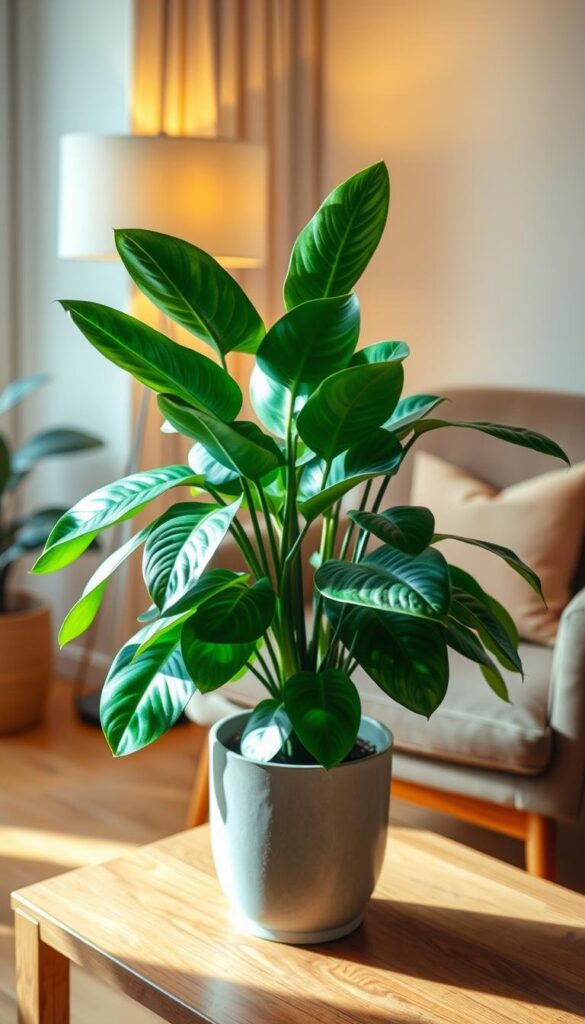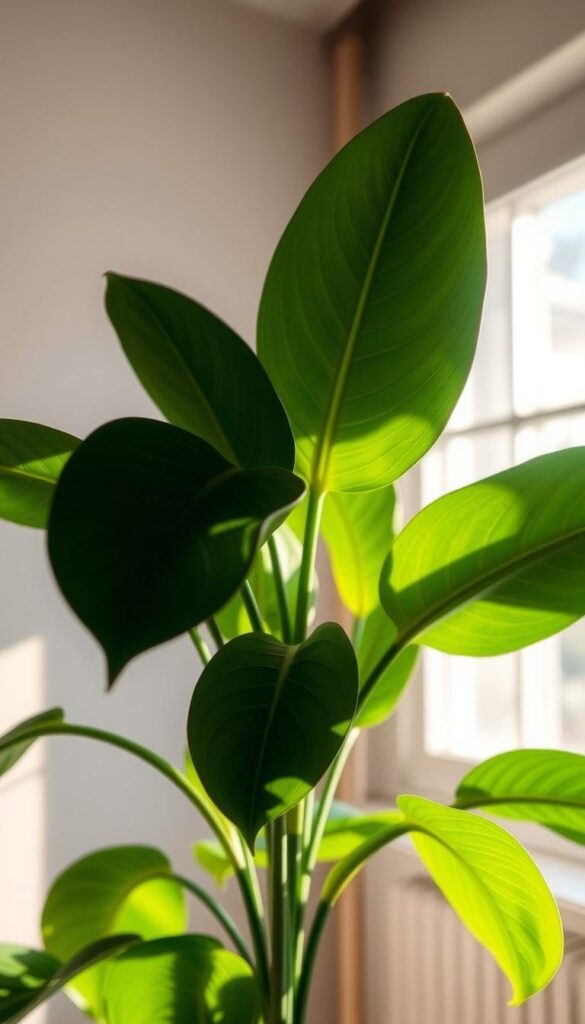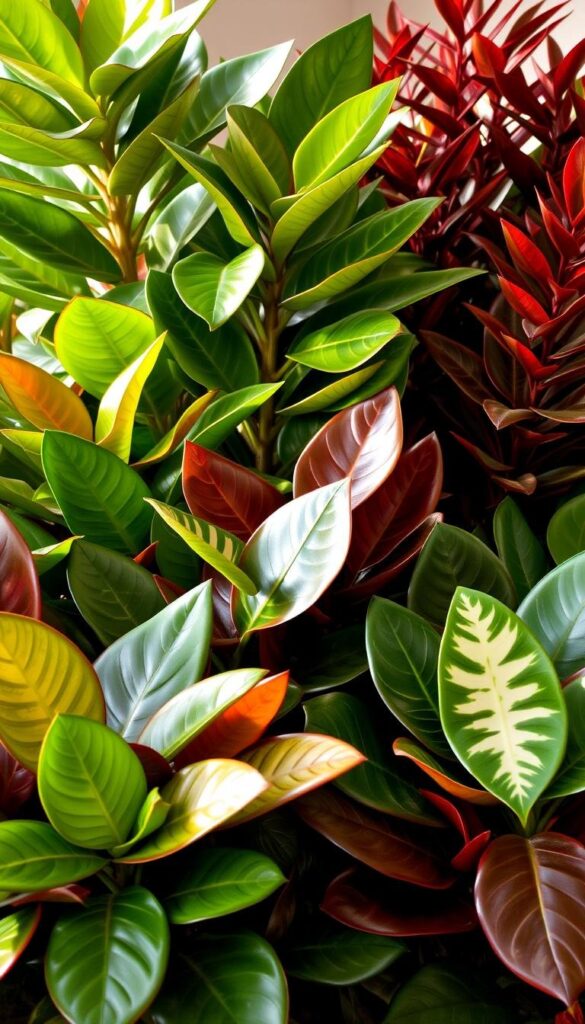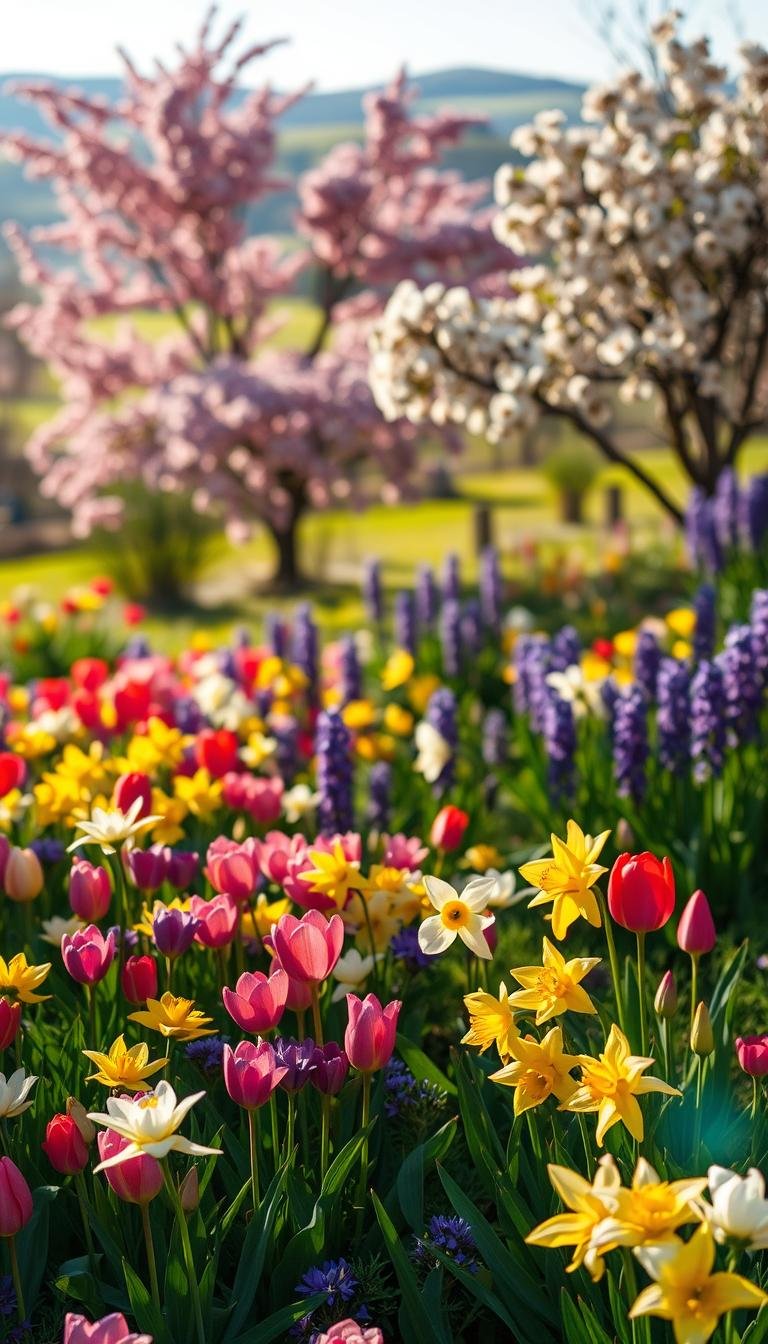This post may contain affiliate links. If you click and buy, we may earn a small commission at no extra cost to you. Learn more.
I’ve always loved how rubber plants add life to any room. These tropical plants aren’t just beautiful—they offer real benefits. They clean the air and bring a touch of nature indoors, making them a top choice for plant lovers.
As someone who’s cared for rubber plants for years, I’ve seen how they thrive with minimal effort. This guide will explore why rubber plants are perfect for home spaces, their care needs, and how to style them for any decor. Let’s dive into what makes the rubber plant a must-have for your home.
Contents
- 1 What is a Rubber Plant?
- 2 Benefits of Having Rubber Plants at Home
- 3 Ideal Growing Conditions for Rubber Plants
- 4 Common Varieties of Rubber Plants
- 5 Care Tips for Your Rubber Plant
- 6 Common Pests and Diseases
- 7 Propagating Your Rubber Plant
- 8 Rubber Plants in Different Spaces
- 9 Troubleshooting Rubber Plant Issues
- 10 Designing with Rubber Plants
- 11 Where to Buy Rubber Plants
- 12 Conclusion: Embrace the Rubber Plant Experience
- 13 FAQ
- 13.1 What are the light requirements for a rubber plant?
- 13.2 How often should I water my rubber plant?
- 13.3 What type of soil is best for growing a rubber plant?
- 13.4 How do I propagate my rubber plant?
- 13.5 What should I do if my rubber plant leaves are turning yellow?
- 13.6 How do I prune my rubber plant?
- 13.7 Are rubber plants safe for pets?
- 13.8 How do I treat pests on my rubber plant?
- 13.9 Can I keep my rubber plant outdoors?
- 13.10 What are the benefits of having a rubber plant in my home?
What is a Rubber Plant?
Rubber Plants (Ficus elastica) come from the lush rainforests of Southeast Asia. They were once a key resource for early rubber industries. Now, they are popular houseplants. Let’s take a look at their beauty:

Origins and History
These plants are from places like India and Indonesia. They were essential for making latex before synthetic materials came along. Their sap was used to make useful items. Now, they are also loved for their beauty in homes.
Characteristics of the Rubber Plant
They have thick, waxy leaves that can grow over a foot long. New leaves start out red, adding excitement to any space. They can grow tall outdoors but fit well in indoor spaces too.
They can handle low light and don’t need much water. This makes them easy for beginners to care for. Look for Variegata for leaves with cream streaks or Black Prince for deep burgundy. Each leaf shines like it’s from the tropics, and their stems show they’re strong.
Benefits of Having Rubber Plants at Home
Adding a rubber plant to your home is more than just a decoration. It’s a way to make your space healthier and more welcoming. These plants bring three key benefits that make them essential for any indoor garden. Let’s explore why they’re a great choice.

Air Purification Properties
The first amazing thing about rubber plants is how they clean the air. NASA research shows they’re excellent at removing formaldehyde. This means you can breathe easier in your kitchen or bedroom. No need for fancy gadgets, just their beautiful leaves working all day.
Aesthetic Appeal
“A rubber plant’s bold silhouette adds instant style to any room.”
As someone who loves indoor plants, I’ve seen how rubber plants change a room. Here are some tips to style them:
- Place near a sunny window for a modern focal point
- Pair with neutral furniture to highlight their rich green hues
- Use as a screen between rooms for privacy and charm
| Room | Why It Shines |
|---|---|
| Living Room | Acts as a bold centerpiece |
| Office | Brings calm to workspaces |
| Entryway | Welcomes guests with tropical flair |
Stress Reduction
Caring for a Rubber Plant Indoor is my daily stress relief. Watering and cleaning their leaves is calming. Studies show that caring for plants lowers stress hormones like cortisol. Their lively presence alone is like a breath of fresh air.
Ideal Growing Conditions for Rubber Plants
Creating the right environment ensures your rubber plant thrives. Here’s how to balance its needs for light, water, and soil.

Light Requirements
Rubber plants need light, but not too much. They do best near east or west windows with filtered sunlight. Direct southern light can scorch leaves, so keep them a few feet away from windows. A north-facing spot works too but may slow growth.
Watering Needs
Rubber plants need careful watering. I check the soil weekly and water when the top inch feels dry. In winter, I cut back watering by half to avoid root rot. Overwatering was my early mistake, so I now let the soil breathe between sessions.
Soil Types
Choosing the right soil mix is key. I use a peat-based potting mix blended with perlite or coarse sand. This combo drains well and maintains moisture without waterlogging. A pH between 5.5 and 7.0 works best for nutrient absorption.
| Factor | Optimal Care |
|---|---|
| Light | Bright indirect light; avoid direct sun |
| Water | Water when top inch dries; reduce in winter |
| Soil | Well-draining mix with perlite, pH 5.5–7.0 |
Adjust these basics to match your plant’s environment. Small changes make a big difference!
Common Varieties of Rubber Plants
I’ve grown rubber plants for years and found each variety unique. They all need proper Rubber Plant Care, but their looks and needs differ. Let’s look at the most popular types for indoor or outdoor spaces.

Ficus elastica
The classic Ficus elastica is my favorite. It has glossy green leaves. The ‘Burgundy’ variety has deep reddish-purple leaves, while ‘Tineke’ has cream-and-green variegation.
These plants prefer indirect light but need consistent moisture. Overwatering is their biggest problem. Their vibrant colors make them eye-catching in any room.
Ficus robusta
Ficus robusta has thick, leathery leaves. It’s more forgiving than others, handling occasional neglect well. Its upright growth is great for smaller spaces.
It does well in brighter light than most Rubber Plant types. It’s perfect for beginners who want a hardy plant.
Ficus lyrata
Ficus lyrata (fiddle-leaf rubber plant) is a cousin of the rubber plant. It has large violin-shaped leaves, similar to the fiddle-leaf fig. But it’s more hardy.
It loves bright light to keep its bold leaves perky. This prevents it from becoming leggy.
Care Tips for Your Rubber Plant
Keeping rubber plants healthy is easy with regular care. Pruning and fertilizing are key. Let’s explore how to do both.
Pruning and Maintenance
I focus on Rubber Plant Pruning in spring. This is when new growth happens. Trimming helps keep the plant looking good and encourages more leaves.
Always wear gloves to avoid getting sap on your skin. Cut just above a leaf node to help new growth. The cut stems are great for starting new plants.

Fertilizing Guidelines
My Rubber Plant Care includes fertilizing once a month from March to September. I use a balanced liquid fertilizer but only at half strength. This prevents burning the roots.
Don’t overdo it, as too much fertilizer can harm the plant. I also flush the soil with water every month. This removes any extra nutrients. In winter, I stop fertilizing to let the plant rest.
- Use 10-10-10 NPK fertilizer diluted to half strength
- Apply after watering to avoid root burn
- Resume feeding in early spring
Wiping leaves with a damp cloth also helps. It keeps them shiny and healthy. These small steps make a big difference.
Common Pests and Diseases
Keeping your rubber plant healthy means watching out for pests and diseases. I’ve learned that catching problems early is key. This way, you can fix issues before they get worse.
Early detection is key—I check my plants every week. I look closely at the undersides of leaves and stems.
Identifying Common Pests
There are three pests that often bother rubber plants:
| Pest | Signs |
|---|---|
| Spider Mites | Fine webbing, yellow spots |
| Mealybugs | Cotton-like clusters on stems |
| Scale Insects | Brown bumps on leaves/stems |
Treatment Options
Start with gentle methods:
- Water Spray: Blast pests with a strong water jet.
- Insecticidal Soap: Apply weekly for persistent infestations.
- Neem Oil: Use for scale insects and severe cases.
For root rot (caused by too much water), remove the plant. Cut off any rotten roots. Then, replant in fresh soil. Make sure not to overwater to avoid root rot again.
Propagating Your Rubber Plant
Starting a new rubber plant family is exciting. It’s all about Rubber Plant Propagation. This method helps you grow new plants from the ones you already have. It also improves your Rubber Plant Care skills. Here’s how I’ve learned to do it:
“Stem cuttings are my go-to—they’re faster and more reliable than seeds.” – My Top Tip
First, pick your method. Seeds vs. Cuttings each have their own advantages and disadvantages:
- Seeds: They offer genetic variety but take 2–3 years to grow. They need consistent warmth and patience.
- Cuttings: They root in weeks. They perfectly copy the parent plant’s traits.
Here’s my Step-by-Step Propagation guide:
- Snip a 6-inch stem just below a leaf node using clean shears.
- Let the cut end dry for 24 hours to form a callus, preventing rot.
- Dip the base in rooting hormone and plant in moist perlite or peat mix. Or, submerge the node in water until roots appear.
- Cover the pot with a plastic bag or dome to trap humidity. Remove daily for airflow.
- Check for new growth in 4–6 weeks—once established, treat the new plant like its parent.
Remember, patience and consistency are key. Each new plant shows your Rubber Plant Care skills. Happy propagating!
Rubber Plants in Different Spaces
My journey with Rubber Plant Indoor and outdoor setups showed me how versatile they are. They fit well in cozy corners or sunny patios. Finding the right spot is key to their success, I’ve learned.
“A Rubber Plant Indoor can turn any room into a jungle oasis.”
Indoor Growing
In my living room, a large Rubber Plant thrives near a west-facing window. It adds drama to the space. Smaller varieties do well in offices or bathrooms with indirect light. Here’s what I’ve found works:
- Bathrooms: High humidity suits them but requires bright indirect light.
- Offices: Desk placement works if near a window with filtered light.
- Living areas: Large plants make bold statements in sunnier corners.
Outdoor Cultivation
In USDA zones 10-12, my Rubber Plants flourish outside. When I lived in Southern California, a patio plant grew twice as big as indoor ones. For colder climates, summer outdoor time boosts growth. Here’s a quick guide:
| Zone | Region | Care Tips |
|---|---|---|
| 10-12 | South Florida, Hawaii | Plant permanently in partial shade; shield from frost. |
| 4-9 | Most US regions | Move outdoors in summer; protect from harsh sun. |
When moving plants between spaces, adjust light gradually. Outdoor plants need more water and space. My plants love summer rain but hate freezing temps. A little planning makes all the difference!
Troubleshooting Rubber Plant Issues
Even with consistent care, Rubber Plants can face problems like yellowing or dropping leaves. Over the years, I’ve found solutions through trial and error. Here’s how to tackle common issues.
Yellowing Leaves
Yellow leaves often mean the plant is stressed. Too much water can drown the roots, causing lower leaves to turn yellow. Not enough water makes the edges crisp and yellow. Also, too little light can make new growth pale.
My first step is always to check the soil moisture with a finger test. Adjust how often you water and move plants to brighter spots if needed.
- Overwatering: Let soil dry 2-3 inches deep before watering.
- Underwatering: Water thoroughly when soil is dry, then let drain completely.
- Light issues: Move to east-facing windows for balanced light.
Leaves Dropping Suddenly
Leaf drop isn’t always a bad sign. Sudden moves or drafts can stress the plant. My biggest plant dropped leaves after moving, but it recovered once it settled.
Drafts near vents or doors can make things worse. Slowly moving plants helps them adjust.
- Avoid placing near heaters or AC vents.
- Relocate plants slowly—shift 1-2 feet weekly to new spots.
- Check for pests like spider mites if drop is severe.
Patience is key. Most problems can be fixed with the right care. Regular checks and quick actions keep your Rubber Plant healthy. Observe, adjust, and your plant will recover!
Designing with Rubber Plants
Adding a Rubber Plant Indoor to your space brings style and life. Their sleek leaves and strong stems fit well in any room. They turn corners, desks, and entries into eye-catching spots.
Styling Tips for Your Home
First, pick a Rubber Plant that fits your space. For small areas, choose compact types like Ficus elastica in modern pots. Big plants are better for large rooms. Match their dark green leaves with neutral walls or bold fabrics.
Creative Uses in Interior Decor
- Put a potted Rubber Plant on a console table to highlight an entryway.
- Use small plants on a bookshelf with art and decor.
- Place a floor plant by windows to reflect natural light.
| Design Style | Rubber Plant Pairing |
|---|---|
| Modern Spaces | Black ceramic pots for minimalist contrast |
| Bohemian Rooms | Basket planters with macramé hangers |
| Rustic Kitchens | Earthenware pots with natural wood stands |
Rotating your plant helps it grow evenly and stay balanced. Their easy care lets you focus on creative placement without daily upkeep worries.
Where to Buy Rubber Plants
Finding the right Rubber Plant can be tough. But, knowing where to look makes it easier. Look for local nurseries or trusted online sellers for a healthy plant.
Local Nurseries
Local nurseries let you see plants before buying. Small, family-owned stores often have strong plants with shiny leaves. They can also give you Rubber Plant Care tips for your home.
In cities like Portland or Austin, you can find rare plants. Look for the Ruby or Tineke for their bright colors. Make sure the soil feels moist before buying.
Online Retailers
If local stores are scarce, try online shops like The Sill and Bloomscape. Look for sellers with great reviews and clear return policies. Here are some tips:
- Choose vendors with climate-controlled shipping
- Opt for plants potted in well-draining soil mixes
- Avoid purchases during extreme weather to prevent shock
After getting your plant, put it in a shaded spot for 7-10 days. This helps it adjust and prevents pests. Whether online or offline, careful research and patience will help your Rubber Plant flourish.
Conclusion: Embrace the Rubber Plant Experience
My journey with rubber plants has shown their unique blend of beauty and usefulness. They purify the air and are easy to care for, making them perfect for indoor spaces. Their shiny leaves brighten up any room and bring a sense of calm.
Starting with a rubber plant is simple. Just remember to give it light and water. They can thrive in various environments, from bright spots to shaded areas. Seeing them grow and bounce back from mistakes shows their strength. It’s not just about the plants; it’s about how they improve our lives.
Getting a rubber plant is more than adding decor; it’s embracing a greener way of living. Their ability to adapt and their long-term benefits make them ideal for both seasoned plant enthusiasts and beginners. Let their natural beauty and durability help make your space healthier and more lively. The right rubber plant can truly transform your home, leaf by leaf.
FAQ
What are the light requirements for a rubber plant?
Rubber plants love bright, indirect light. They can handle moderate light too. I keep mine near east or west windows. Direct sunlight can burn their leaves.
How often should I water my rubber plant?
Wait until the top inch of soil is dry before watering. In spring and summer, water more often. In fall and winter, water less to avoid root rot.
What type of soil is best for growing a rubber plant?
Use a potting mix that drains well for rubber plants. I mix potting soil with perlite or sand. This keeps the soil pH right, between 5.5 and 7.0.
How do I propagate my rubber plant?
Propagating through stem cuttings works best. Cut a healthy stem below a node. Let it callus, then put it in water or soil until roots grow.
What should I do if my rubber plant leaves are turning yellow?
Yellow leaves mean you might be watering too much or too little. Check your watering habits. Fixing this usually helps the plant get better.
How do I prune my rubber plant?
Prune in spring or early summer to keep it bushy. Wear gloves because the sap can irritate skin. Cut just above a leaf node for new growth.
Are rubber plants safe for pets?
No, rubber plants are toxic to pets if eaten. Keep them away from pets to avoid accidents.
How do I treat pests on my rubber plant?
Regularly check for pests like spider mites and mealybugs. A strong water spray can help with small problems. For bigger issues, use insecticidal soap or neem oil.
Can I keep my rubber plant outdoors?
Yes, in zones 10-12, rubber plants can grow outdoors. Place them in partial shade in summer. Bring them indoors in fall to avoid shock.
What are the benefits of having a rubber plant in my home?
Rubber plants are not just pretty; they purify the air too. They remove toxins like formaldehyde. Caring for them also makes your home feel calmer.
To bring you cozy inspiration more efficiently, we sometimes use AI to assist in content creation — but every word and idea is carefully shaped by our team. See our AI Disclosure for more info.







